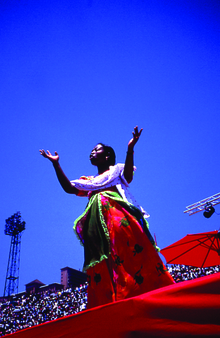Hiragasy
The audience plays an active role at hiragasy events, expressing their satisfaction with the talent of the troupe members and the message they proclaim through applause, cheers or sounds of disapproval.
[2] After independence from France in 1960, the hiragasy troupe was held up as an icon of traditional Malagasy culture, and began to find greater popularity along the coasts, although performances remain largely concentrated in the Highlands.
Among these are the order in which songs, dances and oratory are performed; how troupes are named (after the last name of the founding member and his/her town of origin); what costumes are worn (men typically wear straw hats, red coats and pants inspired by 19th century French military garb, and matching lamba cloth sashes; women wear identical dresses designed after the style popular among ladies of the court during the Imperial period); and which instruments are used.
The Sasitehaka: Over the course of approximately ten minutes, the male members of the troupe settle in the middle of the crowd of spectators as the snare and base drummers beat an accompanying militaristic rhythm.
The Mpikabary (Making Kabary): One of the artists, often the troupe leader or oldest member of the group, will typically take off his straw hat and formally announce the beginning of the spectacle.
He will invite the female members of the troupe to come to the stage and then, after a short instrumental performance, the artist will take about five minutes to introduce the theme (indray miditra) of the show through kabary - a traditional type of formalized and poetic speech incorporating ohabolana (proverbs).
The Renihira (Queen Song): The singers of the group form a circle facing outward and sing in harmony on the selected theme while the musicians, seated to the side, accompany them.
